Sunflowers are heat-tolerant, insect-resistant, and attractive to pollinators and birds. They make beautiful cut flowers, and their seeds are a food source for birds and people. The Sunflower is one of the largest and brightest flowers around. Beautiful, golden-yellow petals bring a sense of joy and a vibrant splash of color to the garden.
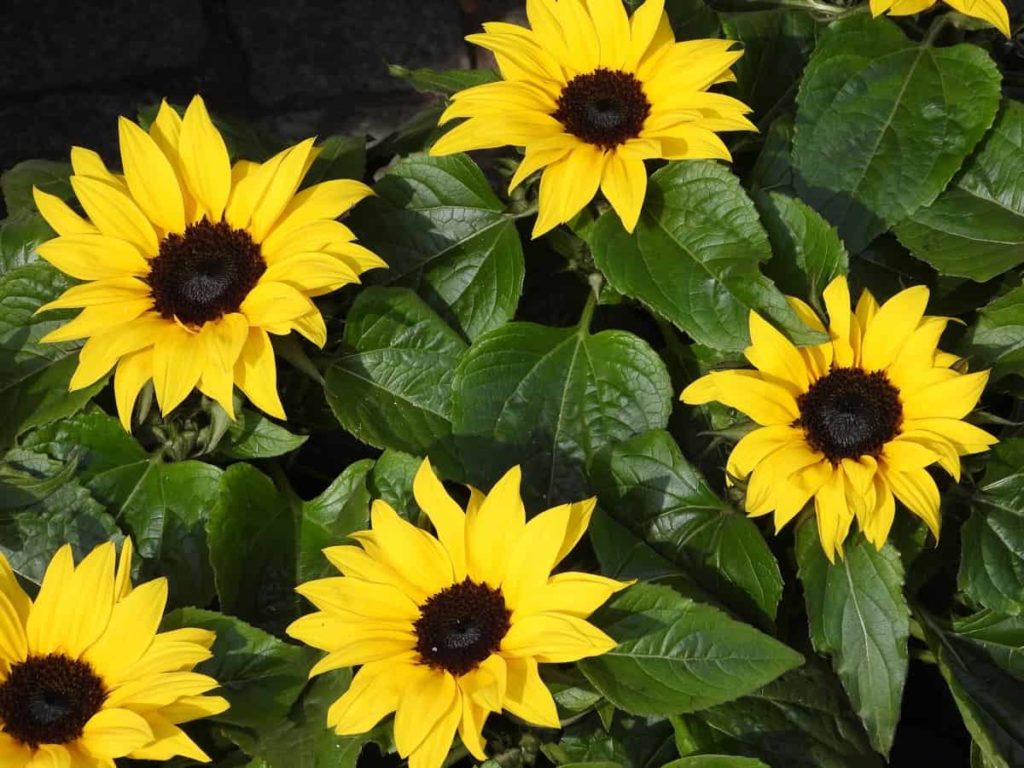
Sunflowers are heliotropic, which means they turn their flowers from east to west to follow the sun’s movement in the sky and then return to face the east at night, re-preparing for the morning sun. Heliotropism occurs during the early stages before the flower is heavy with seeds. Different Sunflowers require different planting depths and spacing. How to grow Sunflowers from seeds and how deep to plant Sunflower seeds depends on your specific Sunflower cultivation.
How to grow Sunflowers from seed to harvest
How long does it take to fully grow a Sunflower from seed?
- There are different types of Sunflowers, each growing at a different rate. You can easily grow Sunflowers from seed. On average, it takes 80 to 120 days for a plant to mature and produce seeds.
- Annual Sunflowers bloom from summer to autumn. Depending on the type, it may take 11 to 18 weeks for them to flower from seed sowing. With that in mind, sowing Sunflower seeds every two weeks is a good idea, so you’ll have a steady supply of pleasant Sunflowers in the summer. Gradually, the Sunflower bud begins to bloom as soon as the flower’s head opens. After about 90 days from planting, the Sunflower will grow fully.
How many Sunflower seeds do you get from one plant?
- Each Sunflower’s head may contain 1,000 to 2,000 seeds. Each seed can be quite different in appearance, but the most common type used for snacking has a black-and-white striped pattern on the hull.
- Seeds are harvested from the heads of large plant flowers, which can measure more than 12 inches in diameter. A Sunflower’s head can contain up to 2,000 seeds.
How many Sunflowers does a plant produce?
- Unlike their one-headed, cultivated cousins, you can grow wild Sunflowers in open fields and ditches, and they have multiple flower heads, up to 20 heads per plant. Both cultivated and wild Sunflowers have substantial but shallow root systems.
- A mature Sunflower is a composite flower consisting of 1,000 to 2,000 small individual seeds per head. These individual seeds are arranged in two opposite helixes starting at the center of the flowering head.
In case you missed it: Top 25 Steps to Boost Sunflower Yield: How To Increase Sunflower Seed Production

Harvesting and storing Sunflower seeds
- Harvest the Sunflower when their petals dry and start falling. Depending on the seed coat type, the seeds will look thick and have completely black or black and white stripes. You should harvest when the back of the flower is brown.
- Once your Sunflower completely dies and the blooming back turns brown, it’s harvest time. You will also notice that the seeds are plump and somewhat loose. You should cut the stalk with sharp scissors or pruners about a foot below the head of the flower and place it in a container that can hold any loose seeds.
What month do you plant Sunflowers?
- You should plant Sunflowers at the end of spring, once the ground is good and warm. Most Sunflower seeds germinate when the soil reaches 21°C to 30°C. The best time to plant Sunflowers is before the soil reaches this temperature.
- Seeds are successfully sown from January to June for flowers during the summer and rainy seasons. A light application of mixed fertilizer at planting time will encourage strong root growth to prevent them from blowing over in the wind.
- With varieties that only require 50 to 60 days of the growing season, you should be able to plant Sunflower in late July for autumn flowers. When growing Sunflowers, you can usually seed from early March to mid-May, but this will vary depending on the variety, so always check the seed packet.
- It is better to sow Sunflower seeds directly in the garden (or outdoor containers) after the danger of spring frost any time has passed after the soil has been warmed to at least 10°C.
Do Sunflowers grow back every year?
While most types of this bright beauty are annual Sunflowers, which means they won’t return in the next growing season. If the Sunflower type is a perennial, it will return naturally and blossom again next year. You should replant annual varieties each year. Sunflowers will also grow back if they self-germinating, growing from seeds that can fall from the plant, provided the heads are left on in the winter.
Do you have to dry Sunflower seeds before planting?
- Whether saving them for planting in next year’s garden or eating, these Sunflower seeds need to be completely dried before they can be stored. If you’re saving seeds for replanting, store them in an airtight container in a cool, dry place until you’re ready to plant.
- Tie paper bags around the seeds in the garden to prevent the birds from harvesting for you. Bundle your Sunflower with twine in bunches, then hang them upside down in a hot and dry area for 4 to 5 days.
Do you plant Sunflower seeds point up or down?
If you plant them down with a narrow-pointed seed end, Sunflower seeds will sprout best. While it’s not strictly necessary, it does give the Sunflower the best possible start in life. Putting that end down where the roots will emerge can save the plant from correcting itself in the ground. You should place the Sunflowers 1 to 2 inches deep, point down every 6 inches, and then cover them.
Water requirement for growing Sunflower
- Watering daily can be harmful to the health of your Sunflower. This is because they love the sun and don’t work well in shady, wet conditions. Instead, plan to water your Sunflower 1 to 2 times per week to keep it alive.
- Sunflowers hate wet feet. They cannot tolerate excess water and are very susceptible to root rot. Give your Sunflower at least 2 gallons of water a week while the seeds germinate. Sunflowers that don’t get enough water during the early stages will have thin, weak stems that can’t keep the head of heavy flowers straight.
- If you’re growing Sunflowers from seeds germinating, they can’t go on for more than a few days without water. Once the Sunflower matures and is above 2 feet in height, it can only get by with water once a week, depending on the conditions.
- Sunflower usually grows well with 1 inch of water per week, whether from rain or supplemental irrigation. Watering plants well 20 days before and 20 days after bloom can improve your Sunflower production.
In case you missed it: Sunflower Questions and Answers – Planting FAQs
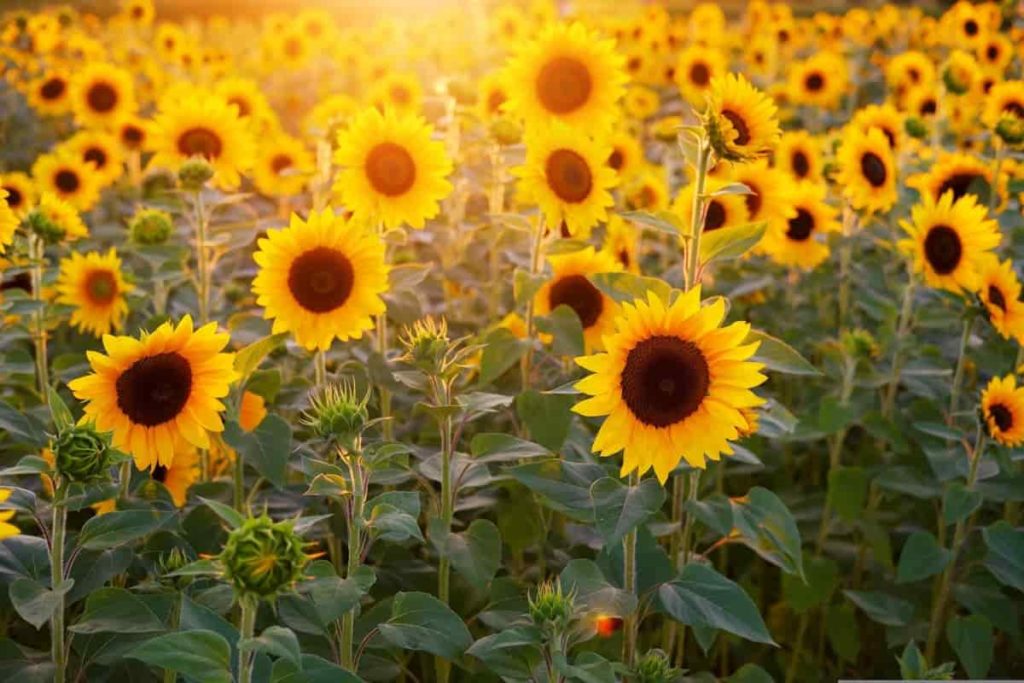
How many Sunflower seeds are in a hole?
- Fill the containers with any commercial potting fertilizer for about half an inch from the top when planting them in containers. You should soak the soil thoroughly, make a hole about an inch deep with a pencil, and leave one seed in your hole.
- If you plant closer, you may find long stalks but smaller heads. The seed head may be large but too heavy to bear the stalk if you plant farther apart.
- To start the Sunflower indoors, plant three seeds in every 3- to 4-inch peat pot. Soilless planting media will provide you with the best drainage. Indoor germination usually takes place in 6 to 10 days.
Do Sunflowers need full sun?
- Sunflowers need full sunlight. You should choose a well-drained location and prepare your soil by digging an area of about 2 to 3 feet. Even though Sunflowers will grow in partial shade, plants deprived of sunlight and warmth are taller and leggy and produce smaller and fewer flowers.
- The Sunflower loves the sun. However, it only works if the temperature is right. Although they still grow, if the temperature rises to 30°C, they will begin to wilt after that. Use a green shade net or something similar to protect the plants from the scorching sun.
- It is unusual for Sunflowers to be damaged by too much sun. An afternoon shade is recommended if you live in a very hot climate with summer temperatures above 32°C. The soil may dry out during drought, negatively affecting flower growth. Stems can become wood if plants are over-exposed to the sun.
Do Sunflowers only bloom once?
- For branching varieties that naturally have more than one flower, the plant will rebloom as the season progresses, and you harvest fresh flowers and deadhead spent ones. Single stem varieties usually won’t recur once cut.
- Annual Sunflowers usually bloom once and need to be replanted the following year. However, you can find new Sunflower seeds emerging from annual Sunflower varieties that have fallen into the soil after they’re finished.
- Annual Sunflowers bloom in summer and autumn. You should sow new plants every few weeks, and you’ll enjoy non-stop flowers until the first frost.
How deep do you plant Sunflower seeds?
- Usually, plant Sunflower seeds at least 1/2 inch deep. Space seeds at a distance of 6 inches. If planting in rows, you’ll want 2 to 3 feet between each row. Plants should be thinned in a few weeks for proper spacing.
- You can poke seeds into the soil about 1 inch deep and 3 inches apart. Thin to 12 inches in all directions for dwarf varieties. Extremely tall Sunflowers or those that grow in multi-branched shrubs may require 3 feet between plants.
- You should plant the Sunflower seeds no more than an inch deep and about 3 inches apart. Thin the seedlings once they are 6 inches tall, leaving the strongest plants about 12 inches apart. For continuous blooming, stagger your planting, sowing a new row of seeds every two to three weeks beginning in spring.
Soil requirement for growing Sunflower
- Sunflowers prefer somewhat alkaline soil pH 6.0 to 7.5; they are heavy feeders, so make sure you plant them in nutrient-rich soil. These beautiful flowers are heavy feeders; thus, the soil needs to be enriched with organic matter. It is recommended that you protect the seeds from strong winds. Although Sunflowers survive in poor soil, they prefer a nutrient-rich environment.
- You should plant Sunflowers in the full sun and rich soil on the north side of the garden so that they do not shade other plants. Sunflowers in sandy soils are not recommended because they need a strong foundation to support their tall, heavy plants.
In case you missed it: Growing Sunflower In Pots – From Seed At Home
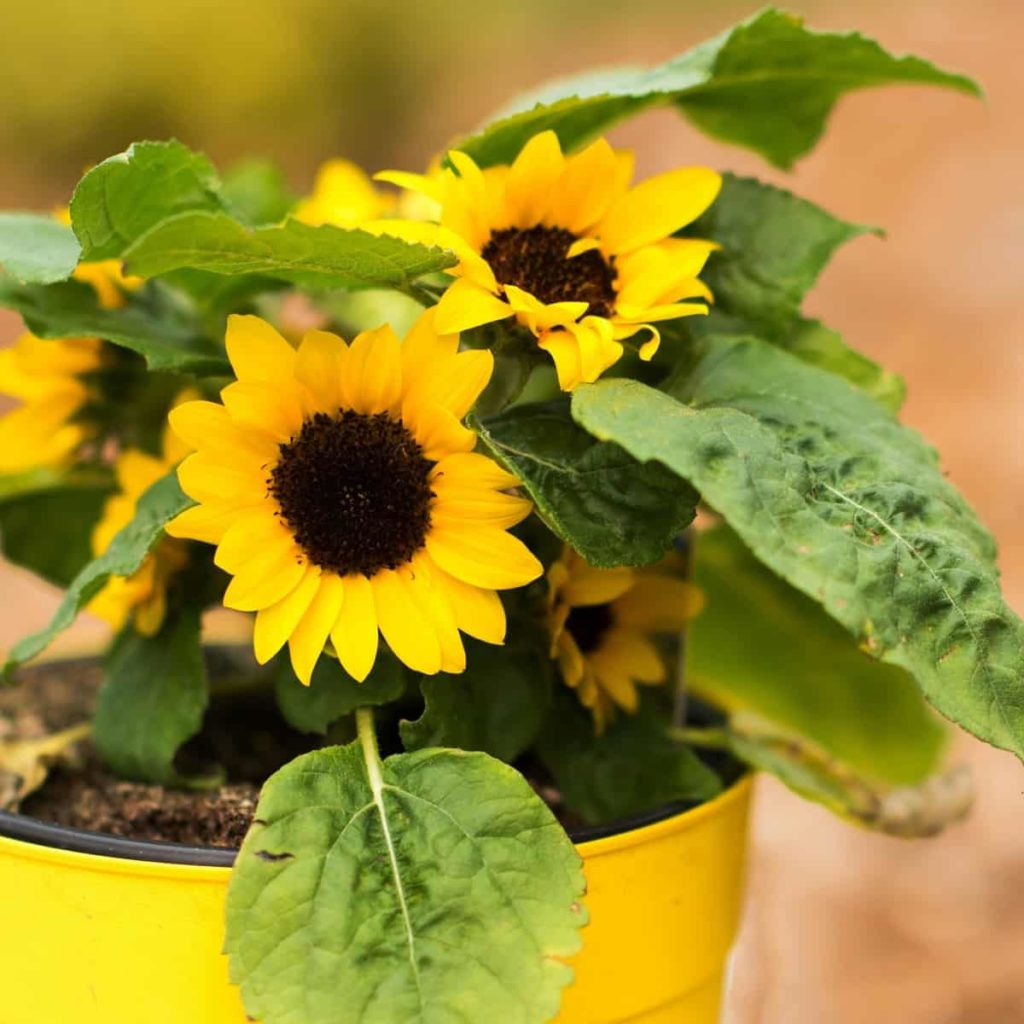
Why does my Sunflower have multiple heads?
Excessive fertilizer use is one of the reasons why we have multiple heads of Sunflowers. Additional fertilizers provide more nutrients to the Sunflower, making it more reproductive, manifested by growing multiple heads of the Sunflower. Only the standard wild Sunflower can grow up to 20 heads per plant. Which is proof of how different they can be from plant to plant.
What grows well with Sunflowers?
- The best companion plants for Sunflowers include Crimson Clover, Pumpkin, Squash, Corn, Lettuce, and Tomatoes. Sunflowers usually provide companion planting, shading cool weather crops from the harsh afternoon sun and attracting pollinators toward garden crops that depend on insect pollination.
- Sunflowers and corn require similar soil conditions to grow. Sunflowers help prevent army pests, which can destroy Corn crops and reduce their production. Cucumbers (as well as Squash and Melons) are heat-sensitive crops that benefit from Sunflower shade. Flowers that go well with Sunflowers include Roses, Snapdragons, Chrysanthemums, Chamomiles, and Irises.
How do you get Sunflowers to bloom?
To grow large enough to produce flower heads, large varieties require plenty of sunlight and a sheltered location. You should choose a place in the garden that receives at least six hours of full sun daily and has light acidic or alkaline soil. Tall Sunflower plants block sunlight from smaller Sunflower plants. If you plant several types of Sunflowers, place the tall plants on the north or east side of the small plants.
Why is my Sunflower falling over?
If your Sunflower seed heads are drooping, it usually signals the end of their growth cycle, not a sign of dehydration. But small plants, and even medium-sized plants, can die because they’re not getting enough water. Staking long Sunflower stems will help support the weight of the budding Sunflower heads.
Growing Sunflower in pots
- Sunflowers that grow low-growing, reaching somewhere between 12 inches and three feet tall, are ideal for containers. They usually don’t need any help, and you can plant one plant in a six-inch pot or three in a gallon-sized container. Sunflowers can be grown indoors at any time of the year if provided with the right environment. Sunflowers need to be watered about once a week.
- Sunflowers will be delighted to grow in a pot. You need to provide them with a container that is the right size for the plant. Some varieties of Sunflowers are much larger than others, so check the height information on your seed packet.
Fertilizer requirement for growing Sunflower
- When it comes to Sunflower fertilization, nitrogen is essential. Fertilizing the Sunflower with nitrogen will also increase the height of the plant.
- Common fertilizer with nitrogen, phosphorus, and potassium will work fine to fertilize Sunflowers. The combination of nutrients should be 10-15-10 fertilizers. Granular fertilizer is ideal in spring because of the slow release of nutrients over time.
- Fertilizer doses of 60-80-60 and 30-40-30 kg NPK per hectare and farmyard manure of 5 tons per hectare are recommended for hybrids and varieties, respectively.
- Sunflowers deplete the soil more than many other crops, especially if you’re growing them to reach a massive height that must replenish the nutrient supply every season. Work in a slow-release granular fertilizer about 8 inches deep in your soil, including trace minerals.
- Sunflowers, however, are heavy feeders, so the soil needs to be nutrient-rich with organic matter or composted manure. Or, work in slow-release granular manure 8 inches deep in your soil. If possible, plant the Sunflower in a place protected from strong winds, perhaps along a fence or building.
In case you missed it: How to Plant Jasmine from Cuttings: A Complete Growing Guide for Beginners
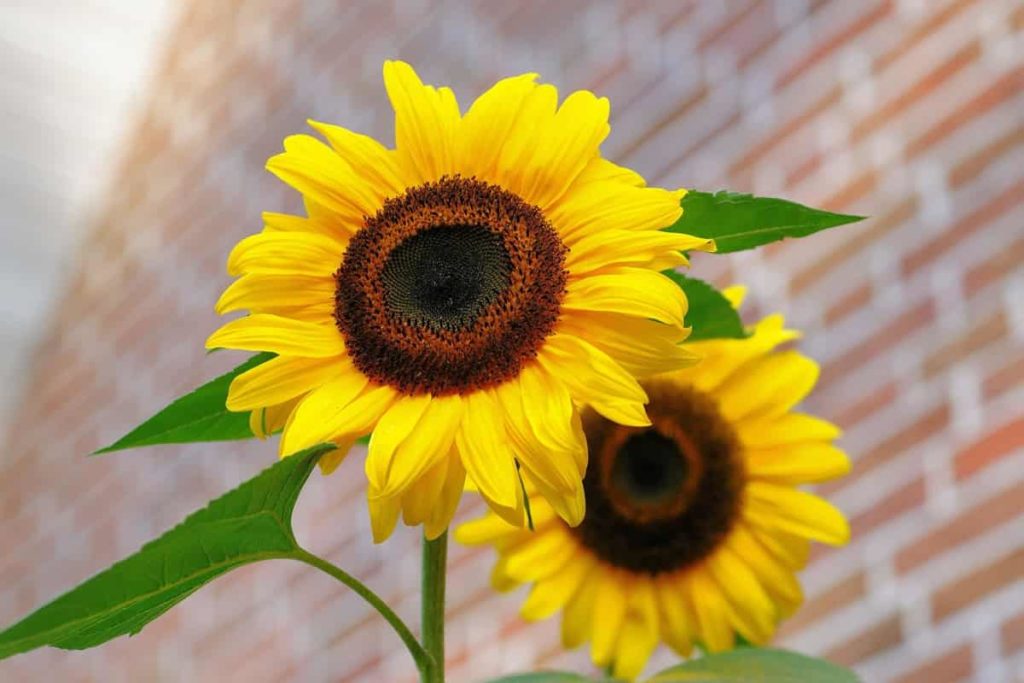
How deep are Sunflower roots?
Sunflower roots typically grow 1 to 3 feet deep, while Sunflowers grow in arid climates, for maximum growth and root growth, they need moisture and soil that is not compacted. Sunflower roots can grow up to 4 feet below the soil surface. Avoid applying fertilizer directly to the stems, as this can cause them to rot. Another way to feed large plants is to make several holes by driving the steel stakes about 3 to 4 feet deep into the ground and about 11/2 feet from the plant.
Can you plant 2 Sunflowers together?
- Sunflowers have long taproots that require enough space to grow. Plant Sunflower seeds one to one inch deep, and plant in warm soil at least six inches apart. Place rows of Sunflowers about 30 inches apart so the plant has room to grow.
- Generally, Sunflower seeds are sown at a depth of 1 inch, seeds at a distance of 6 to 36 inches, depending on the type. You can also sow several seeds close to each other and remove the weak ones after a few weeks.
- In other words, no more than one plant in an 8-inch pot or three plants in a 15-inch pot. In large plants, you can place the seedlings 6 inches apart. Keep the soil moist and well-weeded.
How do you prune a Sunflower?
- You should cut them in half their size in late spring or early summer and then cut them by about a third in June or July. However, once buds start forming, avoid pruning your perennial Sunflower. Sunflowers can grow back. If the Sunflower type is a perennial, it will return naturally and rebloom next year. Annual varieties should be replanted each year.
- Encourage more Sunflowers to grow. Extend the growing season for your Sunflower. Removing the spent flowers allows plant energy to pass into other Sunflowers instead.
- If you deadhead your Sunflower, they’ll keep pumping new flowers to create seeds and more Sunflowers. Don’t cut the stalk back, the next Sunflower is often just inches from where you keep a dead head. Leave the last batch of spent flowers for birds and next year’s flowers.
Germinating Sunflower seeds
- To encourage faster germination, you can soak your Sunflower seeds before planting. Put Sunflower seeds in clean water and let them sit for 24 hours before planting. However, there is no need for this type of soaking. Your Sunflower seeds should grow well if the growing medium is warm and moist enough.
- It takes about 8 to 10 days to germinate. When the seedlings are several inches long, transplant them into large pots at least 12 to 18 inches deep while ensuring they are spread out. Sunflower seeds have an average germination rate of 75%, so 3 out of every four should sprout. Generally, Sunflower seeds are sown at a depth of 1 inch, seeds at a distance of 6 to 36 inches, depending on the type.
In case you missed it: Why are my Tomatoes Rotting on the Bottom and Top: Blossom End Rot, Symptoms, Remedies, and Solutions
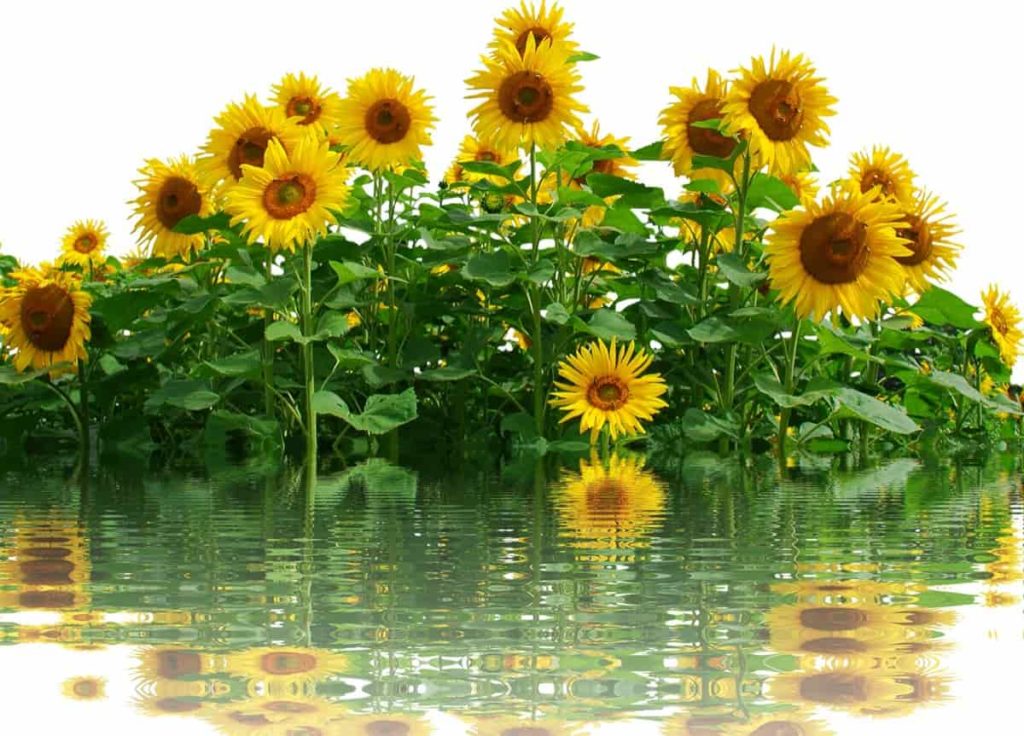
Protecting Sunflower seeds
- Once you see the petals wilting, cover the heads of the Sunflower with brown paper bags, fine netting, meshes, perforated plastic bags, or cheesecloths. Seed tunnels also protect your seeds because they create a physical barrier between the plant and the birds who want to eat them.
- To make the most of your Sunflower seed crop, it’s essential to protect the seeds from fast and hungry birds until they’re ready for harvesting. Cover the seeds to prevent birds from eating prematurely, choosing a cover that allows air circulation, so the seeds continue to ripen.
Conclusion
Sunflowers are one of the most colorful and pleasant plants for gardens. They’re quick to grow, attractive to pollinators, and beautiful. Wide varieties of Sunflowers are available nowadays, so it’s a must-fit one in your garden. Choose between branched or single stems, those that produce enough pollen for pollinators or are pollen-free (best for bouquets), those that stay smaller or tower above the rest of the garden, or those that produce edible seeds. You can use them for chopped flowers, leave them on the stalk for a beautiful outdoor display in your garden, or harvest and eat their seeds.
- Gardening Techniques in Planting Vegetables
- Where to Place Indoor Plants in Your Home
- How to Grow Tomatoes Organically at Home: A Comprehensive Guide
- Organic Gardening on a Budget: Low-Cost Methods and Materials
- Gongura Seed Germination and Planting Methods
- Cabbage Seed Germination and Selection
- Broccoli Seed Germination and Selection
- Asparagus Seed Germination and Variety Selection
- Seasonal Flower Gardening: Best Practices for Spring, Summer, Fall, and Winter
- How to Grow Hibiscus from Flower
- Plantation Ideas for Home Decoration: A Beginners Guide
- Flower Garden Designs and Layouts for Beginners
- Planting and Spacing Techniques in Papaya: A Beginner’s Guide
- Growing Gold: Essential Techniques for Planting Pineapples
- How to Make Kalanchoe Plant Bushy: Home Remedies and Solutions
- 11 Reasons Why Your Gardenia is Not Blooming: Home Remedies and Solutions
- Eco Elegance: The Guide to Designing a Drought-Tolerant Landscape
- Gardening on a Slope: Strategies for Hillside Landscaping
- Nourish and Flourish: Top Organic Mulches for Thriving House Plants
- Everything You Want to Know about Indian Mogra Flower: Discover Uses and Growing
- Green Thumb Success: Expert Tips for Cultivating Greenhouse Pumpkins All Year Round
- Maximize Growth & Flavor: The Ultimate Guide to Companion Planting in Herb Gardens
- How to Control Rhododendron Problems Naturally: Home Remedies and Organic Ways to Fix Them
- Natural Magic: The Remarkable Benefits of Cinnamon for Plants
- Best Steps to Revive Dying Tulip with Natural and Organic Treatment
- 10 Reasons Why Your Angel Trumpet is Not Blooming: Remedies and Treatment
- How to Fix Periwinkle Leaf and Flower-Related Problems: Natural Remedies and Solutions
- How to Fix Zinnias Leaf and Flower Problems: Discover Natural and Home Remedies
- Organic Steps to Induce Lemon Tree Flowers: A Comprehensive Guide
- Bloom Booster: Crafting the Perfect Homemade Bougainvillea Fertilizer
- Optimizing Growth: A Guide to Applying NPK Fertilizer for Potted Plants
- 10 Best Homemade Fertilizers for Rubber Plant: DIY Recipes and Application Method
- How to Boost Female Pumpkin Flowers: Effective Steps for More Flowers and High Yields
- Transform Your Indoor Garden: Top Benefits of Pink Salt for Houseplants
- 10 Best Homemade Fertilizers for Peacock Plants (Calathea): Easy DIY Guide
- Unlock Blooms: 9 Reasons Why Your Potted Chrysanthemum is Not Blooming